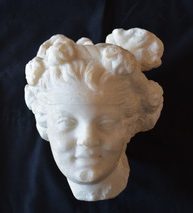I.D. no: 48917
Dimensions: H. 25 cm; Max. W. 19 cm
Material: Coarse-grain white marble
Provenance: Unknown
Current location: Domvs Romana Museum, Rabat
Condition: Broken off from its original statue at the neck, the head survives in very good condition. The break is oblique, slanting from above the nape at the back to Adam’s apple at the front. A deep circular hole occupies the centre of the rough surface of the break, while a shallower mortice-shaped depression is located below it. Both are probably modern. Traces of slight wear on some parts of the hair. Minor chips affect the nose tip, chin, neck, and behind the left eye.
Description: The head is turned sharply to its left and leans slightly forward in relation to the strongly inclined neck. The hair is drawn back sideways and upward in impressionistically agitated and twisted tufts, and gathered on top of the head in a high ‘corymbus’ supported by a horizontal fillet that is visible only across the forehead. The head is also encircled by a twisted band mounted with small bundles of flowers on the front, down to the ears, and two apparently of leaves behind them. A wayward pointed lock has escaped from the main hair body and fallen over the fillet above the left eye, two others in front of the ears. The oval face is marked by pronounced cheek bones which agitate the facial planes and provide a pleasant chiaroscuro effect. It is given an attractive smiling expression rendered by the half-shut eyes and slightly parted sensual lips. The irises and pupils are lightly incised, turning the playful gaze upward to the left.
Discussion: The ‘corymbus’ on top of the head is most commonly associated with female divinities, like Aphrodite (including some examples in the collection of the National Museum of Archaeology), but we also find it in male, but effeminate, representations like the Apollo Sauroktonos of Praxiteles and the ‘Resting Apollo’ of the Uffizi Gallery.[1] On the other hand, the overall complicated hairstyle and the crown of leaves and flowers, as well as the horizontal fillet on the forehead give the head a strong resemblance with several iconographic types attributable to Dionysus.[2] The very young and feminine features of the face, however, favour a different identification even if it may have to be sought in the Dionysian realm. In fact, it very probably represents a female follower of Dionysus, a young maenad or bacchante.
The captivating dreamy smile that characterizes the face is found also, almost identical, in the head of the nymph in the famous Hellenistic group known as the ‘invitation to dance’,[3] but the latter is facing the opposite direction. The pictorial effect achieved by the agitated facial muscles and the flaming hairstyle, the asymmetry of the face produced by the hearty smile, and the sharp cut of the narrow eyelids and eyebrows are closely paralleled in the head of a putto from Sperlonga.[4] In the latter we also find the same asymmetry of the face provoked by the smile.
Nevertheless, the most striking parallel is to be found in an almost identical replica, a ‘jugenliche Bacchantin’ formerly in the Museo Gregoriano Profano of the Vatican Museums,[5] since 1988 in the Museo Chiaramonti, Sezione XXII 9 which, however, has some missing and unworked parts of the hair at the back.[6]
Date: an excellent decorative work of the late-Hadrianic or Antonine age probably derived from a Hellenistic original of the Rococo style of the second half of the second century BC.
Bibliography: (previous publications of item):
Bonanno 1971: 160-164; 1992: 158, pl. 24.
[1] Mansuelli 1959: figs 46 a-b, 47.
[2] Jones 1926: 131, no. 8, pl. 46; 134, no. 11, pl. 49
[3] Bieber 1961: 139, figs 564, 567. See also Kaschnitz-Weinberg 1936-37: 88-90, no. 180, pl. 36.
[4] Iacopi 1963: 135-138, figs 129-132; Cassieri 2000: 69-71, fig. 33.
[5] Marked as no. 10304. Benndorf and Schöne (1867: 66, no. 96, pl. 3, fig.1) judged it as a ‘gute griechische Arbeit’ and cited a ‘replica’ in the then Palazzo del Ministero della Pubblica Istruzione in Florence.
[6] Vorster 2004: 143, no. 86, pl. 104, 1-2 (dated to the 2nd c. AD).

